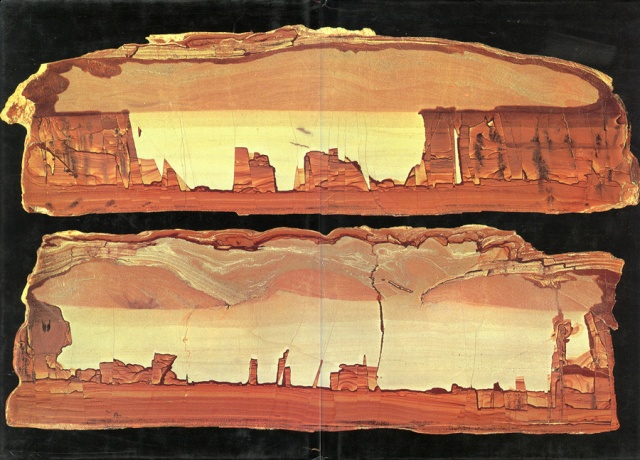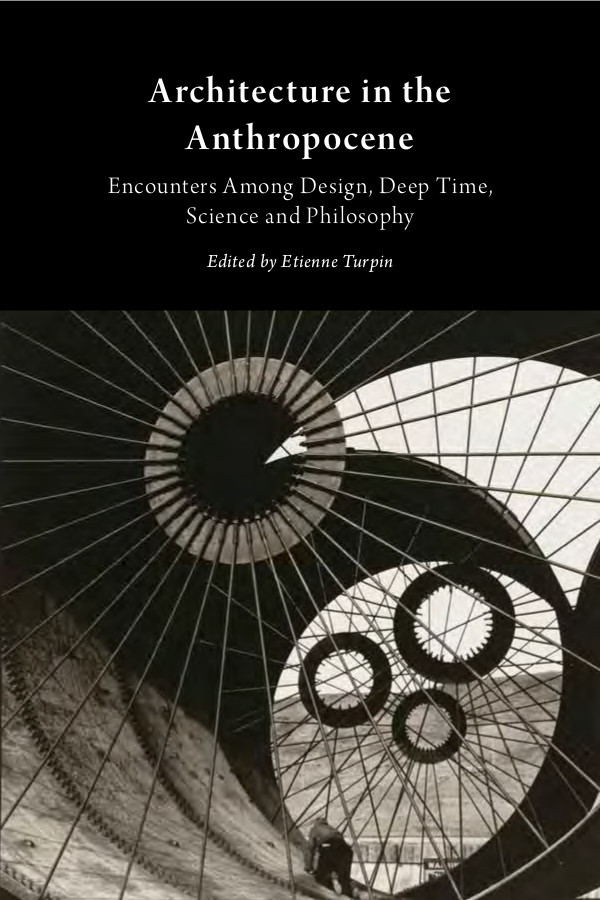Roger Caillois: The Writing of Stones (1970/1985)
Filed under book | Tags: · calligraphy, geology, mineralogy, writing

“The Writing of Stones is a fascinating meditation on the human imagination contemplating the interior of stones. Caillois examines patterns that are revealed by polishing sections of minerals such as agate, jasper, and onyx. He considers the impact these configurations have had upon the human imagination throughout history and he reviews man’s attempt to categorize and explain them.
Marguerite Yourcenar [in her introduction] points out that ‘there had taken place in [his] intellect the equivalent of the Copernican revolution: man was no longer the center of the universe, except in the sense that the center is everywhere; man, like all the rest, was a cog in the whole system of turning wheels. Quite early on, having entered ‘the forbidden laboratories,’ Caillois applied himself to the study of diagonals which link the species, of the recurrent phenomena that act, so to speak as a matrix of forms.’ Caillois found the presence throughout the universe of a sensibility and a consciousness analogous to our own. One way which this consciousness expresses itself is in a “natural fantasy” that is evident in the pictures found in stones. Man’s own aesthetic may then be no more than one of many manifestations of an all-pervasive aesthetic that reveals itself in the natural world.”
First published as L’ecriture des pierres, Editions d’Art Albert Skira, Genève, 1970
Translated by Barbara Bray
With an Introduction by Marguerite Yourcenar
Publisher University Press of Virginia, Charlotesville, 1985
ISBN 0813910501, 9780813910505
108 pages
via pink panter
Commentaries: Marina Warner (Cabinet), 50 Watts.
Interview with author (video, 26 min, 1974, ina.fr, in French, via Véfa Lucas)
PDF (5 MB, updated on 2020-11-19)
Comments (5)Etienne Turpin (ed.): Architecture in the Anthropocene: Encounters Among Design, Deep Time, Science and Philosophy (2013)
Filed under book | Tags: · anthropocene, architecture, climate, climate crisis, design, earth, ecology, geology, meteorology, philosophy, science, time, weather

“Research regarding the significance and consequence of anthropogenic transformations of the earth’s land, oceans, biosphere and climate have demonstrated that, from a wide variety of perspectives, it is very likely that humans have initiated a new geological epoch, their own. First labeled the Anthropocene by the chemist Paul Crutzen, the consideration of the merits of the Anthropocene thesis by the International Commission on Stratigraphy and the International Union of Geological Sciences has also garnered the attention of philosophers, historians, and legal scholars, as well as an increasing number of researchers from a range of scientific backgrounds. Architecture in the Anthropocene: Encounters Among Design, Deep Time, Science and Philosophy intensifies the potential of this multidisciplinary discourse by bringing together essays, conversations, and design proposals that respond to the “geological imperative” for contemporary architecture scholarship and practice.”
Contributors include Nabil Ahmed, Meghan Archer, Adam Bobbette, Emily Cheng, Heather Davis, Sara Dean, Seth Denizen, Mark Dorrian, Elizabeth Grosz, Lisa Hirmer, Jane Hutton, Eleanor Kaufman, Amy Catania Kulper, Clinton Langevin, Michael C.C. Lin, Amy Norris, John Palmesino, Chester Rennie, François Roche, Ann-Sofi Rönnskog, Isabelle Stengers, Paulo Tavares, Etienne Turpin, Eyal Weizman, Jane Wolff, Guy Zimmerman.
Publisher Open Humanities Press, December 2013
Critical Climate Change series
Creative Commons Attribution Non-Commercial No-Derivatives 3.0 Licence
ISBN 1607853078, 9781607853077
250 pages
HTML (added on 2016-7-19)
PDF, PDF, PDF (10 MB, updated on 2016-7-19)
Elizabeth Ellsworth, Jamie Kruse (eds.): Making the Geologic Now: Responses to Material Conditions of Contemporary Life (2012)
Filed under book | Tags: · art, earth, geology, land, photography

Making the Geologic Now announces shifts in cultural sensibilities and practices. It offers early sightings of an increasingly widespread turn toward the geologic as source of explanation, motivation, and inspiration for creative responses to conditions of the present moment. In the spirit of a broadside, this edited collection circulates images and short essays from over 40 artists, designers, architects, scholars, and journalists who are actively exploring and creatively responding to the geologic depth of “now.” Contributors’ ideas and works are drawn from architecture, design, contemporary philosophy and art. They are offered as test sites for what might become thinkable or possible if humans were to collectively take up the geologic as our instructive co-designer—as a partner in designing thoughts, objects, systems, and experiences.
Recent natural and human-made events triggered by or triggering the geologic have made volatile earth forces sense-able and relevant with new levels of intensity. As a condition of contemporary life in 2012, the geologic “now” is lived as a cascade of events. Humans and what we build participate in their unfolding. Today, and unlike the environmental movements of the 1970s, the geologic counts as “the environment” and invites us to extend our active awareness of inhabitation out to the cosmos and down to the Earth’s iron core.
A new cultural sensibility is emerging. As we struggle to understand and meet new material realities of earth and life on earth, it becomes increasingly obvious that the geologic is not just about rocks. We now cohabit with the geologic in unprecedented ways, in teeming assemblages of exchange and interaction among geologic materials and forces and the bio, cosmo, socio, political, legal, economic, strategic, and imaginary. As a reading and viewing experience, Making the Geologic Now is designed to move through culture, sounding an alert from the unfolding edge of the “geologic turn” that is now propagating through contemporary ideas and practices.
Publisher Punctum Books, Brooklyn, New York, December 2012
Creative Commons BY-NC-ND 3.0 License
ISBN 9780615766362
262 pages

